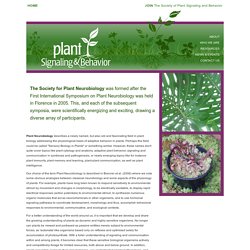

Towards understanding plant bioacoustics. International Laboratory of Plant Neurobiology. Action Potential - How a Neuron Fires. Definition: An action potential is part of the process that occurs during the firing of a neuron.

During the action potential, part of the neural membrane opens to allow positively charged ions inside the cell and negatively charged ions out. This process causes a rapid increase in the positive charge of the nerve fiber. When the charge reaches +40 mv, the impulse is propagated down the nerve fiber. This electrical impulse is carried down the nerve through a series of action potentials. The plant as a biomechatronic system.
Tree of Life as of 2006. Stefano Mancuso: The roots of plant intelligence. Swarming Behavior in Plant Roots. Electrical signaling and photosynthesis: Can they co-exist together? 2005 Symposium Book of Abstracts. Society of Plant Signaling and Behavior. The Society for Plant Neurobiology was formed after the First International Symposium on Plant Neurobiology was held in Florence in 2005.

This, and each of the subsequent symposia, were scientifically energizing and exciting, drawing a diverse array of participants. Plant Neurobiology describes a newly named, but also old and fascinating field in plant biology addressing the physiological basis of adaptive behavior in plants. Perhaps this field could be called "Sensory Biology in Plants" or something similar. However, these names don't quite cover topics like plant cytology and anatomy, adaptive plant behavior, signaling and communication in symbiosis and pathogenesis, or newly emerging topics like for instance plant immunity, plant memory and learning, plant-plant communication, as well as plant intelligence. For a better understanding of the world around us, it is important that we develop and share the growing understanding of plants as dynamic and highly sensitive organisms.
Plant neurobiology - The science of plants. Plants Repel Bacteria's Assaults by Spying on Their Chatter. Bacteria are quite the talkers.

Lying low inside their hosts, they scheme up attacks through coded biochemical messages that are largely imperceptible to the immune systems of plants and animals. But in December researchers published the first evidence that some plants have broken the code, allowing them to listen in on chatter and thwart infection. Evidence for this reconnaissance emerged in 2009, when University of California, Davis, plant pathologist Pamela Ronald discovered a bacterial protein called Ax21 in some strains of rice. Whenever Ax21 was present, the plants flooded their tissues with antibacterial chemicals. The mere presence of an immunity-inducing protein like Ax21 was not that unusual—the immune systems of most organisms identify a microbial intruder through proteins protruding from its outer membrane.
Ronald’s discovery may spark similar finds. Establishment of Glucocorticoid-Mediated Transcriptional Induction of the Rice XA21 Pattern Recognition Receptor. The Secret Social Lives of Plants. We may not think of them as outgoing beings, but it appears that plants have evolved ways to know who is growing nearby.

And just like people, some plants do better in a social setting while others prefer the solitary life. Botanists have observed that many trees do not grow well near members of their own species, but they were uncertain how the trees could tell. A recent study offers an answer. Surprisingly, newly sprouted seeds do not seem to respond directly to chemicals from their mature relatives; rather, they probably react to soil-dwelling microorganisms near the trees’ roots.
Biologist Scott Mangan and his colleagues at the Smithsonian Tropical Research Institute found that five tropical tree species grew better in soil collected near another kind of tree than in dirt gathered near their own species. Sagebrush plants, in contrast, may fare better when they are surrounded by their own kind. Talking Plants. Ian Baldwin works in a lab anyone could love: a large blackened burn area high on a steep slope in the Great Basin Desert of southwestern Utah.

Here a distant mountain range shimmers blue and lavender, the nearer craggy cliffs of Veyo Ridge hover in red, and the curves of the desert hills are dotted green by Joshua trees and scrub. Baldwin, a biologist and the director of the Molecular Ecology Department at the Max Planck Institute for Chemical Ecology in Jena, Germany, has stationed his equipment here to launch a new study of how plants defend themselves—a question he has pursued for 20 years. He and his colleagues are using chemical sensors to investigate plant communications: cries for help, invitations, even warnings, each in the form of odor molecules that float past human noses unnoticed. The harder biologists look for these signals, the more they find. The scorched area they're studying was struck by lightning a year ago, clearing the hillside of juniper and sagebrush.